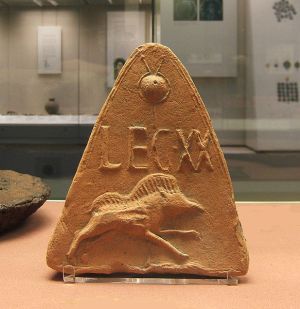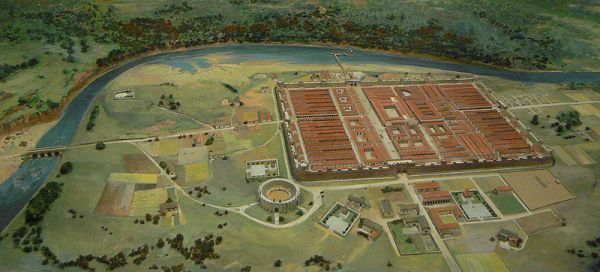Chapters
Legio XX Valeria Victrix was probably created between 31 and 26 BCE during the reign of Octavian Augustus. The most likely version is that of Antony’s 20th Legion, which, after the Battle of Actium, retreats east and becomes part of Octavian’s forces with the old number. Coins minted by Antony have been preserved, depicting the eagle of the legion of the XX legion, and a warship can be seen on the reverse.
The matter of the legion’s name is also not entirely certain. Most likely, the legion received the nickname “Valeria” in CE 6 after a victorious battle with the insurgents, in honour of its commander Valerius Messalinus. Whereas “Victrix” after the liquidation of the Boudicca uprising in Great Britain. Valeria – translates as “black eagle”, but can also be translated as “brave”. Victrix means “victorious”. “Boar” – the legion’s emblem, the same legions had: I Italica, II Adiutrix and X Fretensis. The Sabine symbol of the god Kwiryn, the protector of soldiers, also identified with Romulus himself.
Cantambria/Asturias (25-13 BCE)
The beginning of the 20th legion’s existence was a heavy transition in the war with Cantabras and Asturias (25-13 BCE) – the only peoples who faced Rome in today’s Spain. To conquer this small patch of land, Augustus brought an additional five to the three legions stationed, including the XX legion. The Asturians and Cantanbras turned out to be masters of guerrilla warfare. For centuries, serving in various armies as mercenaries, they coped well in the initial period of the war. Fights had to be fought for fortified hills and repelled deadly driving attacks. The Spanish tribes suddenly attacked the main forces during the march and cut off supplies. It was during this war that the Romans adapted the famous circulus cantabricus and cantabricus impetus. When the natives, surrounded on the hills, had no hope of escaping, they killed themselves or drank poison from the yew tree. Despite such harsh conditions, the commander of Augustus’ army, Marcus Vipsanius Agrippa, smashed the main forces of the Asturians and Cantanbras in two campaigns. However, the legions had to stay there longer. During this war, the legionaries of XX Valeria Victrix operated from land. Smaller revolts broke out until 13 BCE The first veterans of the XX Valeria Victrix legion were settled in the village of Emerita.
Italia / Pannonia / Dalmatia
Probably in the twenties BCE the vexillatio of the XX legion was transferred to Aquileia, and then the entire legion. After years of defeats inflicted on the Germans, only the Marcomanni posed a threat to the borders of the empire in this period. August sent Tiberius in CE 5 to continue his work from previous years and end the Marcomanni case once and for all. Tiberius had prepared the expedition as thoroughly as possible. The Germanic legions, under the command of Sentius Saturnin, were to attack the state of Maroboduus from the Hercynian Forest, while Tiberius was to cross the Danube. Marbod got to know Rome perfectly because he spent his youth in Italy as a hostage. He prepared his army in the Roman style, armed of course in Germanic. He had 70,000 infantry and 4,000 cavalry. Tiberius opposed him with a force of a total of 12-13 legions along with auxilia. They also included the vexillatio XX summoned from Illyria or Italy. Carnuntum stopped along with the other legions of Tiberius. However, the plans for the attack came to nothing, when behind the backs of the future emperor’s troops there was a bloody uprising in Dalmatia and Pannonia in 6 CE. Panic broke out in Rome, as there was no army to defend Italy. Tiberius went to the rescue, leaving the Marcomanni hidden in Bohemia (today’s Czech Republic).
During the fighting in Illyria, the XX legion became famous for fighting an unequal battle with the forces of the insurgents. Commanded by the governor of this province – Marcus Valerius Messalinus (consul from 5 CE), surrounded, he defeated 20,000 insurgents and broke through the enemy line. Here is how he presented the activities of the legion Velleius Paterculus (Roman History, II.112) “[…]twentieth legion, and that at but half its normal strength, he routed and put to flight more than twenty thousand, and for this was honoured with the ornaments of a triumph” Velleius indicated only half of the legion, the rest were still on the Danube with Tiberius or had already marched with his army. Messalinus’ forces were the outpost of the main forces. Pannonia falls under the blows of the legions in 8 CE. During this period, the base of the 20th legion was the winter quarters of Tiberius – Siscia. The fighting in Dalmatia, on the other hand, continues until 9 CE Legion XX is actively involved in bringing peace. The natural conditions of Dalmatia forced them to constantly attack the fortified hills, marching through deep and narrow ravines. Legionnaires were tasked with cutting off groups of insurgents and depriving them of supplies. Hunger did the rest. From 9 CE the legion seizes a new base in Burnum, Dalmatia.
Germania
The defeat of the legions in the Teutoburg Forest changes the plans for the 20th Legion. He is immediately transferred to the two legionary fortresses in Ara Ubiorum (Colonia Claudia, along with the legion I Germanica). From this base, it operates in Germany. Initially, these were two unsuccessful campaigns with Tiberius (CE 10 and 11), which missed the point as the Germans avoided direct clashes with his troops. Tiberius changes the division into provinces in this area. He brings to life with Gaul Belgici two Teutons. Both provinces (Lower and Upper) come under Germanicus. Each province had a crew of 4 legions. When Emperor Augustus dies, in 14 CE a dangerous rebellion takes place in the legions of Pannonia and Germania, the cause of which is the long service time and the failure of the new emperor to pay the sums that Augustus promised legionaries in his will. The Legions of Lower Germania were commanded at that time by the legatus pro praetore Aulus Caecina. After Germanicus returns from Gaul (along with the tax money), the legionaries force the collection of a cash equivalent.
The fifth and twenty-first legions declined to move until the sum was made up and paid where they stood, in the summer camp, out of the travelling-chests of the Caesar’s suite and of the prince himself. The legate Caecina led the first and twentieth legions back to the Ubian capital a disgraceful march, with the general’s plundered coffers borne flanked by ensigns and by eagles. Germanicus set out for the upper army, and induced the second, thirteenth, and sixteenth legions to take the oath of fidelity without demur; the fourteenth had shown some little hesitation. The money and discharges, though not demanded, were voluntarily conceded.
Among the Chauci, however, a detachment,12 drawn from the disaffected legions, which was serving on garrison duty, made a fresh attempt at mutiny, and was repressed for the moment by the summary execution of a couple of soldiers. The order had been given by Manius Ennius, the camp-marshal, and was more a wholesome example than a legal exercise of authority. Then as the wave of disorder began to swell, he fled, was discovered, and as his hiding offered no security, resolved to owe salvation to audacity:— “It was no camp-marshal,” he cried, “whom they were affronting; it was Germanicus, their general — Tiberius, their emperor.” At the same time, overawing resistance, he snatched up the standard, turned it towards the Rhine, and, proclaiming that anyone falling out of the ranks would be regarded as a deserter, led his men back to winter-quarters, mutinous enough but with training ventured.
– Tacitus, Annals, I.37-38
From then on, both legions support Germanicus and go with him to Castra Vetera, where there was still a rebellious mood among V Alaudae and XXI Rapax. After calming the rebellion, Germanicus decides to give the legionaries something to “do”. An expedition to the nearest tribe – Mars. During the march, a fight similar to the one in the Teutoburg Forest takes place. The entire column is under attack, but the main target of the hastily assembled German army is the rear guard. Then Germanicus approaches the soldiers of the 20th Legion, according to Tacitus says “that this is the time to wipe out the rebellion from memory: let them press forward, let them hurry to turn their guilt into pride.” So encouraged, the legionaries throw the Germans into the open space and succeed.
Then the legion still participates in Germanicus’ expeditions to the lands of Khattów and Cherusci in 15 and 16 CE. The expeditions were conducted with varying luck. During one of the expeditions, Caecina’s legions (including the 20th) regained the legionary eagle of the 19th legion. The Bructerii were destroyed in constant battles, but when they joined the legions of Germanicus, a breakthrough in the fighting took place. The sight of the corpses in the Teutoburg Forest negatively affects the morale of soldiers. During the fights with Cherusci, after the first defeat of the cavalry, Germanicus loses his fighting spirit and orders his retreat. Caecina’s legions are given the unfortunate order to return over the “long bridges”, a road previously built in the marshes and swamps by Lucius Domitius. Paweł Rochala in his book “Teutoburg Forest 9 CE” mentions that perhaps it was supposed to be a punishment for “poorly” fighting legionaries. However, I believe that Germanicus was guided by the hope that such a decision would somehow confuse the Germans or in a fit of panic, he wanted to save himself, and direct the attention of the Cherusci and Arminius to the “drowned in the swamps” legions of Lower Germania, to which he could still hate for the recent revolts. In any case, the legion comes out of the constant fighting without the caravans, but with all the marks.
In 16 CE, not discouraged, with the loss of the fleet for 6 legions, Germanicus tosses the Weser (1,000 ships in the fleet take part in the action) legions deep into Germany. In two great battles, he destroys the enemy’s forces. The XX legion also takes part in both. Unfortunately, failures of a “natural” nature – the continual defeats of the fleet with the sea cause the dismissal of Germanicus. His successor – Druzus no longer shows such willingness to go on great expeditions. The following years pass for the 20th Legion guarding the limes and minor skirmishes with the Germans. Only in 21 CE did the legion take part in more serious battles against the rebellious Gauls. Around 35 CE, he is transferred to the legion base in Novaesium, where he is stationed with V Alaudae, but the next stage is soon to come – Britain.
This legion was one of four that accompanied Emperor Claudius in the invasion of Britain in CE 43. The Legion, along with other legions, defeated the Britons led by Caractacus at the Battle of the River Severn in CE 50 Legion built the camp Camulodunum (now Colchester, England) where most of the detachment was stationed. Some units were stationed at Kingsholm, Gloucester, and a garrison at Wroxeter. In 60-61 CE, the legion helped crush Queen Boudica’s revolution. Then the legion “settled” in the Deva Victrix camp. During the events of the “year of the four emperors”, the legions supported Vitellius. Some of the units accompanied him on the march to Rome. In 78-84 CE, the legion took part in the war campaign of General Gnaeus Julius Agricola in northern Britain and Scotland. The legion built a camp at Inchtuthil, which the Romans called Pinnata Castra (“fortress on the wing”) or Victoria. In 88 CE the legion returned south and settled for two centuries in the Deva Victrix camp. Legio XX Valeria Victrix was involved in the construction of Hadrian’s Wall; it is possible or not in the construction of the Antonin Wall. During the usurpation of Karausius (286-293 CE) and Allectus (293-296 CE), the legion was still operational. It is believed that the legio 20th Valeria Victrix was still stationed in Britain until the time of the usurpation of Constantine III (407-409 CE). Then, in 407 CE, the self-proclaimed emperor moved the unit to the contingent and used it in his military campaign. The fate of the legion is not entirely clear.









